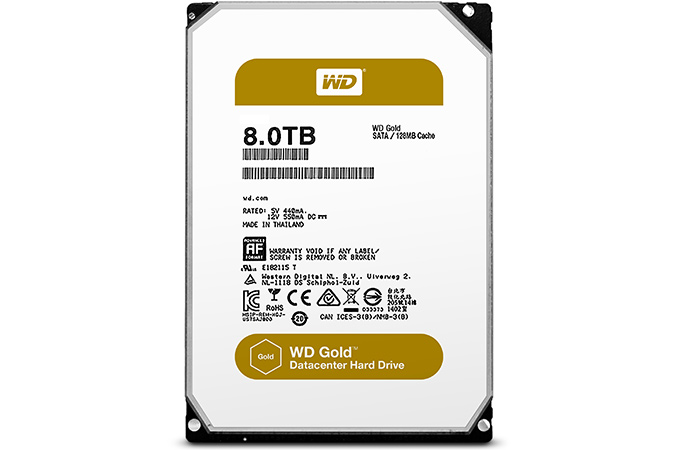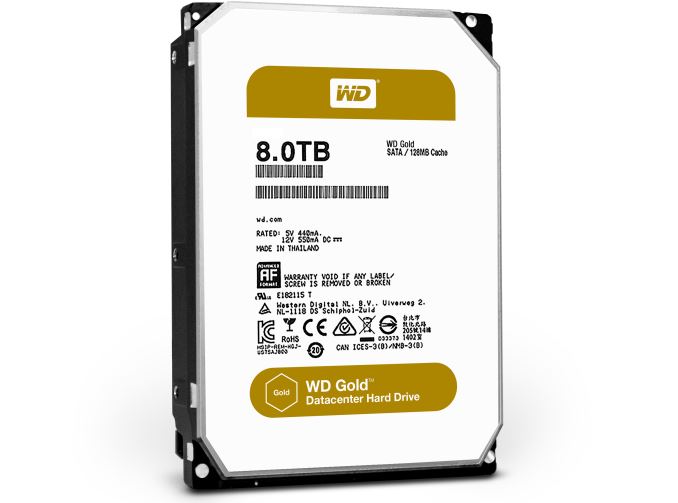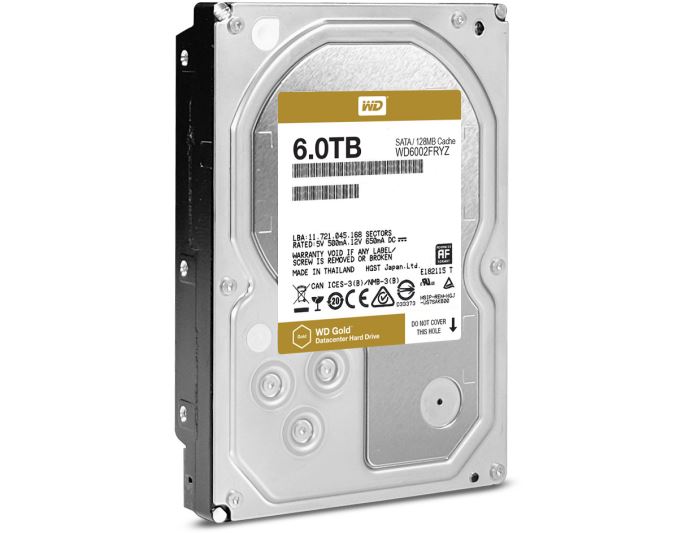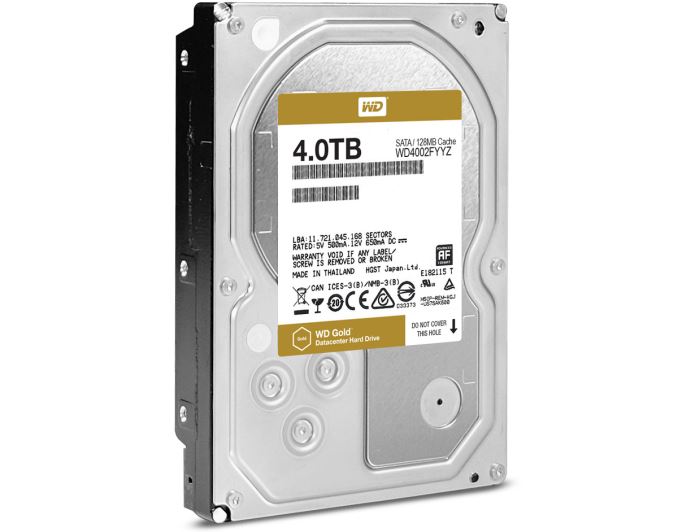Western Digital Introduces WD Gold HDDs for Datacenters
by Anton Shilov on April 19, 2016 9:10 AM EST- Posted in
- HDDs
- WD
- Western Digital
- Enterprise
- WD Gold
- HelioSeal

Western Digital has announced a new family of hard drives specifically for data centers. The new WD Gold HDDs will feature multiple technologies that the company uses to build other drives, including helium and large caches. The WD Gold HDDs will co-exist with the company’s WD Re drives for some time, but as the new family expands, it will eventually replace the previous-gen devices.
The initial WD Gold family will consist of three models: with 4 TB, 6 TB and 8 TB capacities. All three drives seem to be based on different platforms and on different platters, but all of them have 7200 RPM spindle speed and feature new-generation electronics, which is claimed to improve power efficiency by up to 15% according to WD. The new drives come in a 3.5” form-factor and will use SATA 6 Gbps interface exclusively at this point. The WD Gold HDDs are designed for a variety of applications, including small to medium-scale enterprise servers and storage, as well as rack-mount data center servers and storage enclosures.
| Comparison of Western Digital's WD Gold HDDs | |||||
| WD8002FRYZ | WD6002FRYZ | WD4002FRYZ | |||
| Capacity | 8 TB | 6 TB | 4 TB | ||
| RPM | 7200 RPM | ||||
| Interface | SATA 6 Gbps | ||||
| DRAM Cache | 128 MB | ||||
| NAND Cache | No | Yes | Unknown | ||
| Helium-Filling | Yes | No | |||
| MTBF | 2.5 million | ||||
| Rated Workload (Drive Writes Per Day) | 0.189 | 0.251 | 0.377 | ||
| Equivalent of 550 TB of Writes per Year | |||||
| Acoustics (Seek) | 36 dBA | ||||
| Power Rating | 7.40 W | 9.10 W | |||
| Warranty | 5 Years | ||||
| Price | $629 | $499 | $309 | ||
| $0.0768 per GB | $0.0812 per GB | $0.0754 per GB | |||
| 13.02 GB per $ | 12.31 GB per $ | 13.26 GB per $ | |||
Being data center-oriented HDDs, the WD Gold hard drives are optimized for RAID environments and they support enhanced RAFF technology that protects against vibration (by monitoring linear and rotational vibration in real time) as well as head positioning system with two actuators, which improves positional accuracy. The drives also support WD’s time-limited error recovery technology (TLER), which prevents drive fallout caused by extended HDD error recovery processes.
The flagship WD Gold hard drive with 8 TB capacity is Helium based, similar to the HelioSeal platform originally designed by HGST. Western Digital does not reveal the number of platters inside the drive but confirms that these are PMR (perpendicular magnetic recording) platters. Using helium rather than air between the platters helps to reduce power consumption of HDDs compared to non-helium models due to the lower drag force coefficients of helium compared to air - this allows for less friction between heads and the air, as well as platter spinning. All WD Gold HDDs are rated for 2.5 million hours MTBF to signal high reliability.
Next up is the WD Gold 6 TB HDD, which uses a more regular HDD arrangement in air, but which features a media-based cache to improve random write performance over the previous generation WD Re 6 TB hard drive. WD is claiming up to 30% better random write performance. Western Digital does not reveal a lot of details about its “media-based cache”, but it is logical to assume that it uses NAND flash memory as a write buffer which then spins down onto the platters during downtime. Unfortunately, we have no idea about its capacity or actual performance. The drive features modern PMR platters and it may be the world’s first data center-class hybrid HDD (with rotating media as well as NAND cache) for nearline applications. It is interesting to note that also the drives are sold under the WD trademark, they have HGST's markings, which may mean that they were developed by Western Digital's Japan-based subsidiary.
The entry-level WD Gold 4 TB model is claimed to offer up to 18% sequential performance improvement over previous-generation WD Re 4 TB data center drives, but the company does not reveal whether the new HDDs also feature any media-based cache, or its performance advantages are a result of the new electronics, new platters, and/or a new controller. Just like the 6 TB model, the WD Gold 4 TB has HGST Japan marking.
The new family of WD Gold hard drives demonstrates how Western Digital can build HDDs that are tailored for particular needs, which is becoming more important in an industry that is seeing unit volumes decrease over time. The flagship WD Gold 8 TB is optimized for lower power consumption and higher capacity, whereas the mid-range WD Gold 6 TB is optimized for performance.
The new WD Gold HDDs are available at select distributors and resellers in the U.S. as well as from the company’s online store.
Source: Western Digital













30 Comments
View All Comments
dragosmp - Tuesday, April 19, 2016 - link
Looks like a rebadged HGST helium drive, good for themnathanddrews - Tuesday, April 19, 2016 - link
The real question is whether or not to hold out for the platinum or diamond model. /marketingFlunk - Tuesday, April 19, 2016 - link
WD, marketing overdrive since 2003.Samus - Tuesday, April 19, 2016 - link
Seriously. If I were going to buy a company (HGST) and they had a good reputation, I'd keep them around and just collect the revenue/profits of the ownership. WD doesn't have to be all narcissistic about it...besides, the WD Re line has a good reputation, why the hell are they phasing it out!?What's next, Intel ditches the Core and Xeon names for something new and unfamiliar?
Spede - Saturday, April 30, 2016 - link
Personally I've never wanted to buy any IBM-related disk after a bad experience, which includes HGST down the line.WD on the other hand, whilst of course not immune to failures, has a strong and steady brand. It'd be foolish not to make use of it.
crimsondoor - Wednesday, August 3, 2016 - link
HGST has the lowest failure rate by far and this is very consistent across all their products. Read the Backblaze reports. WD and Seagate has much higher failure rates.JoeyJoJo123 - Tuesday, April 19, 2016 - link
Hard drives still aren't getting more affordable in $/GB for a few years now. It's like these hard drive manufacturers want to die out compared to flash-based storage (particularly TLC-based).ddriver - Tuesday, April 19, 2016 - link
There is no competition in this area. There is only 2 main players, and they have probably agreed not to give each other a hard time, this way they can milk consumers without significantly improving their offerings.As mature of a technology as HDDs might be, there is still a lot to be done, especially now that micro-controllers have become much more powerful, it won't be that much of a stretch to make HDDs that rival and exceed the sequential performance of PCI-E SDDs at a fraction of the cost.
Space Jam - Tuesday, April 19, 2016 - link
>it won't be that much of a stretch to make HDDs that rival and exceed the sequential performance of PCI-E SDDs at a fraction of the costOh yeah, no big deal, HDs just increasing read performance by a full order of magnitude and necessitating PCIe capable controllers in hardly any time at all because it's no big stretch.
Yup, believable, it'll happen, HDs win again boys!
ddriver - Wednesday, April 20, 2016 - link
Nobody cares what you believe. It is technically possible, the only reason it has not happened is a lousy and lazy industry.